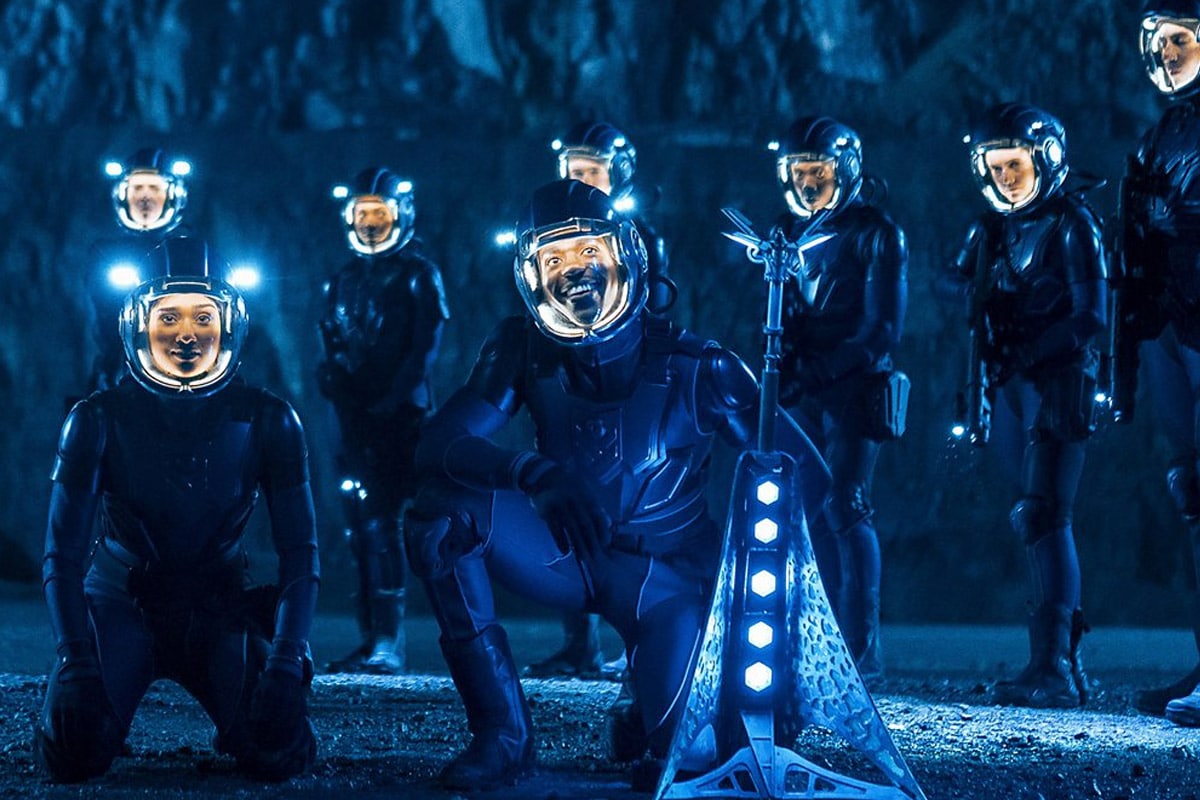- Series: 10
- Episode: Two
- Duration: 50 minutes
- Writer: Frank Cottrell Boyce
- Director: Lawrence Gough
“I’m smiling here, 20 light years from home”
First there was Blink, then there was Listen. We can really wait for Taste and Smell, but while we do, we’ve got Smile. And unlike Listen before it, Smile really does make an attempt to sit in the lineage of that first, famous warning, best employed when walking between shy stone statues: Don’t Blink. Only this time it’s reversed. And just as “Do blink” wasn’t made for tension, “Must smile” doesn’t quite get the blood pumping. And sure enough, the monster of the piece doesn’t prove particularly durable, or even existent…
“You don’t steer the TARDIS, you negotiate with it”
Series 10 has reverted to New Series reboot basics, throwing a new companion into the future, after discovering the Doctor in the present, and shortly before he rockets them back to the past. There’s even a vintage delight in a final scene that rediscovers the Doctor’s poor sense of timing — or so it seems. But there you go, second paragraph and the second mention of this story’s conclusion.
While there is certainly some gruesome danger to overcome in this vividly filmed story, Smile is a tale that all-too quickly capitulates to its one one-word, one joke title, just as much as it hangs on the growing, sparkling relationship between the Doctor and Bill and great nods to the show’s heritage.

Fearful symmetry
Smile marks writer Frank Cottrell Boyce’s return to Doctor Who and the Twelfth Doctor. In Series Eight, his pen brought us the pace-changing In the Forest of the Night. A subdued tale quietly hidden in the latter part of that downbeat series, it sat quietly between the superb Flatline and the two-part finale. Hidden by foliage indeed. But while it was a quiet revolution in a perverse run of stories, it never stood a chance of lighting up the the Whoniverse with the same brightness as the solar flares it featured. And while Smile picks up Forest’s same quiet confidence and naturalistic themes in its first glorious shots of wheat shields, its demons are less fairy tale and far more contemporary than that earlier story.
Cottrell Boyce is exactly the kind of writer Doctor Who should be attracting and reusing. A big name, and authentic northern voice, a writer who knows his way around working with big name film directors as much as story telling for children. And in his latest tale, his strengths are clear as he seizes the baton of Bill’s introduction from Steven Moffat without faltering. He’s a canny choice, keeping Bill’s still fresh discovery of the Doctor’s life just that. And it’s this relationship that’s Smile’s great success.

The crew
“Two thumbs up for Wiltshire-slash-Aberdeen”
Like The Pilot, the second episode is light on its cast. For much of it’s main run-time Peter Capaldi and Pearl Mackie are left to their own devices. Wandering around a vast, futuristic and deserted colony — actually the City of Arts and Sciences in Valencia — the two have plenty of time to riff off each other and the show’s history. Once again, Capaldi’s performance seems more suppressed than his previous series, and all the stronger for it. It really allows his occasional moments of action shine. And that’sdespite his continuing disposition to destroy eveything. But while his increased introspection works wonders, and his Twelfth Doctor has truly arrived in this quietened form, it’s a tightrope. I hope the tension sticks as Bill loses her freshness, not that there’s much sign of that happening.
Capaldi’s chemistry with Mackie is striking, suggesting a far greater reboot than Moffat’s actually served up for his final year. The relationship really works, with genuine misdirection and surprises that don’t feel forced (“stop trying to keep me out of trouble”). It’s certainly helps that unlike Amy or Clara, Bill isn’t saddled with enigma. But somehow, even dialogue that foreshadows to the point of smashing through the fourth wall doesn’t rub when it sparkles between these two (“I want to see if it’s happy”). Nor even in context of the convenient writing out of Matt Lucas’ Nardole at the beginning — perhaps the first notable intervention of the production schedule on this series.
Happy references
“We’re in a utopia of vacuous teens”
Smile’s second great strength is that it holds classic Doctor Who at its core. While The Pilot had frequent nods, this second episode is dripping in its history. In this white haven, there’s a mystery hidden in sight and even an HQ — the ‘ship’ at the centre — to find and infiltrate. And the Doctor’s arrived to do just that. that shines through despite the gloriously contemporary gimmick.
Fans were quick to draw comparisons with Season 25’s The Happiness Patrol. But while there are tonal links beyond the title and loosely connected dystopia, for me the tone lay earlier in the 1980s. You could see the Fifth Doctor bounding around this deserted colony, an idea that Murray Gold’s retro score supported.
The main reference however, was the show’s return to one of humanity’s great migrations, as the entire population of Earth fled planet-scouring solar flares. First introduced during what’s still quite probably the show’s greatest season, 1974’s The Ark in Space contained us human who’d overslept in the orbit of their home planet long after flares hit around the 30th century. Closer to the time of those flares, Series Five’s The Beast Below took us onto Starship UK, as did spin-off videogames and the first incarnation of the Doctor Who Experience. There the entire population of the UK, except Scotland, had disembarked Sol 3 on space vessel. With every visit, exploration of that exodus take us further away from Ark writer Robert Holmes’ Biblically-inspired original. But in many ways Smile is a semi-sequel to The Beast Below. Itself a second episode, Beast’s the Smilers were another man-made horror, and cover for something darker, but in that case subverted by superstition. In both, the hook isn’t the evil hidden in humanity, but the inherent arrogance, ignorance and perpetual lack of preparation.
As with Cottrell Boyce’s first story, Smile finds the human race in heed of external help from outside to survive — intriguingly that first time, against imminent solar flares, but in the far future the human race clearly still has much to learn. Smile is certainly more effective than both In the Forest of the Night and The Beast Below, especially in returning an emotion to the show not felt since the reboot’s early years. The moment Bill realises, incorrectly, that she’s witnessing the last remnants of humanity is a great example, But tellingly, that success is all to do with the new companion and not the plot.

The smile fades
“Emoji. It speaks emoji”
While Smile’s conceit is simple, the science fiction strong, and the visual’s memorable… The plot can’t sustain it. A certain zing is lost in an apparent monster that turns out to be neither foe nor friend. The swarm bots, the vardy named for real-life swarm robotosist Andrew Vardy, are functional but barely memorable. Any creeping dread of their being the city is lost in a certain clinicism. And as much as Bill’s presence injects emotion, the root cause of their turn to the horrific is forcibly clinical.
That cause, the misinterpetation of grief, also draws a number of links to Dark Water and Death in Heaven. The Series Eight finale may have fluffed its lines with excess misery, but it had its own spin on gothic dread. Smile’s attempts to seed an optimistic future with inherent horror and death are ambitious, but fall apart in comparison to truly dystopic tales of the future, like the human soul-destroying Utopia.
By the end, it’s clear that Smile’s issues are there from the pre-title sequence. Featuring, and finishing, nearly half the guest cast, the presence of this expositionary opening seems clumsy. It purposely turns the story into a whydunit rather than a whodunit or howdunit, and that’s a questionable decision.
As for the adventure’s main hook it’s a story of two halves. The sweet and superbly designed robots have a facial syncing that’s slightly overused to the point of contradiction. The end joke where their face lights up with ‘$’ is as cute and knowing as Bill’s lines at the start. In contrast, the emoji badges that attach to the TARDIS crew’s backs are a marvelous idea, and well used. Director Lawrence Gough has great fun with those, drawing out some wonderfully staged double-reactions and misdirections. The Doctor is made tp that kind of cloying, emotional exposure — and the accompanying lines as he acts and sciences his way throught it are superb. With smiley faces though, it’s hard to pull out compelling suspense, even when the wall’s are alive.
Smile’s real issue comes in its all-to-simple resolution, backed by an overly long, and rather smug, explanation from the Doctor. Ending a hostage situation, no matter how contrived, and dissolving the simmering violent battle for survival with a quick software reboot is cheap. In fact, a reset as soon as the Doctor, rather inexplicably, realises that the vardy and interfaces have become self-aware is quite strange indeed.
But then, the soft rush of it all is the point. It’s more concerned with what happens before and after. Smile’s a great proponent of two major facets that have defined the success of New Series Doctor Who. There’s the long, spectacularly filmed build-up. And then post-resolution, there are the flipped tables, and the moral issues that flip with them. In Smile, the slave race have become the masters and a new, re-balanced future of peace is required. But while it’s more effective in showcasing the flaws of humanity of other future tales — The Doctor’s Daughter is a prime example — does the Doctor’s solution really have to be that simple?
I might have smiled a bit more had that resolution hadn’t been so soft.
Stunning moment
“You know what I like about humanity? It’s optimism”
The opening shot, Gladiator and Silent Running, all beautifully framed and bundled. that pre-title sequence is there for a reason. The 1970s Hollywood science-fiction vibe is there and its glorious.
Everyday hook of the week
How does the Doctor put it? “Grief as plague…”
Doctor look of the week
Plenty of looks this week, from the exasperated ‘mum’ when he decides to abscond from Earth, and away from Nardole’s judging eye, to the passion and zeal he displays when he resolves to destroy the colony. The most under-played? The ambiguity when frantic sabotage of the colony ship’s engine is interrupted by a small, robotic interloper.
Production touch of the week
The emoji badges are exquisite. Primed and used to exquisitely subvert some of the action.
A Jokerside view
Somewhere, in a parallel universe, probably five billion years in the future, the old woman Bill stumbles across is a Cat. “That’s mine, that’s mine, that’s mine…” I mean, the colonist’s ship may resemble an all too modern film USS Enterprise, but there’s a sting of Red Dwarf to the whole endeavour.
Verdict
Smile was more about reassurance rather than setting a new bar. At the heart, there’s a concept too weak to maintain Smile‘s early promise and the slightest hint of a lack of confidence in the pre-title sequence. It’s the perfect showcase for the increasingly impressive chemistry brewing in the TARDIS control room, and crucially, it features a Bowie quote (Hope you’re happy too…). But the impression that there could have been so much more remains long after the Next Time rolls. While Frank Cottrell Boyce’s first story for the series hid in the closing throes of a series, his latest is likely to remain hidden in the opening waves.
Review previously published on Medium (April 25, 2017)









0 Comments